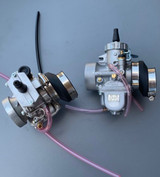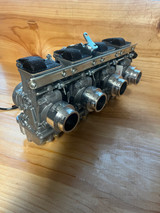How Motorcycle Carburetors Work
Carburetors are found in cars, motorcycles and even equipment like gas lawn mowers. But over the years electronic fuel injection systems started replacing them. However, many motorcycles on the road still use carburetors, so how do they work?
The Basics of a Carburetor
The job of motorcycle carburetors is to supply the engine with the right mixture of fuel and air. Fuel burns in air, but it needs the right amount in order to burn efficiently. This ideal ratio of air to fuel is usually quoted as 14.7:1.
Motorcycle carburetors use a fairly impressive bit of physics to ensure the right mix of fuel and air enter the engine. But how do motorcycle carburetors work?
How Motorcycle Carburetors Work
Carburetors are mechanical components, rather than electronic. They are made out of metal, and they’re connected to both the engine and a fuel reservoir. This reservoir is separate from the fuel tank, and it’s from here that fuel is drawn into the engine.
Motorcycle carburetors work using the physics of the Bernoulli principle and the venturi effect. Inside the carburetor there is a narrow section of what is essentially a tube. Air flows through this tube, and as it passes through the narrow section it speeds up. When it speeds up, the air pressure decreases.
A Difference in Air Pressure
As this part of the carburetor is connected to the fuel reservoir, the lower air pressure below the fuel reservoir – created by the fast-moving air – is lower than that of the air pressure in the fuel reservoir itself.
This causes some fuel to be drawn into the carburetor, where it then passes into the engine and generates power. The reason the air moves through the carburetor in the first place is to do with the negative pressure the pistons inside the engine create when they move down the cylinders.
Applying the Throttle
This sucks air through the carburetor, in turn drawing fuel into the engine along with it. When the rider applies more of the throttle, a valve inside the carburetor allows more air to pass through. This higher volume of air also moves faster, lowering the pressure further, drawing in more fuel to the engine, allowing for more power and more speed.
Releasing the Throttle
When the rider releases the throttle, a smaller, slower moving volume of air passes through the carburetor. This in turn draws in less fuel, which leads to less power generated in the engine and lower speeds.
Choke
One useful mechanism inside motorcycle carburetors is the choke. This is an air restrictor that limits the amount of air sent through the carburetor itself. It creates a vacuum inside the lower part of the carburetor, which pulls more fuel into the engine, while the air flow is still limited.
This creates a richer fuel mixture, which is useful for cold starts. Because colder weather makes it harder for fuel to vaporize, you can have a hard time getting the engine going. Therefore, a choke is a very useful component of motorcycle carburetors.
This is a bit of a generalization, as there are lots of other smaller components that help regulate the flow of fuel and air. However, this is essentially how motorcycle carburetors work.
Different Types of Motorcycle Carburetor
There are two main types of motorcycle carburetor, and the first is the mechanical slide carburetor. In this type, when the rider presses or releases the throttle, a slide inside the carburetor moves up or down. This determines how much air flows through the carburetor, and therefore how much fuel goes into the engine. These are common in racing motorcycles.
The second type is a constant velocity carburetor. These are ideal for riding at different altitudes, as they offer a smooth throttle response. In these carburetors, the slide moves as a result of a valve opening and closing, with the resultant vacuum lifting the slide.
Disadvantages of Motorcycle Carburetors
If motorcycle carburetors are so simple and fairly reliable, why were they replaced by fuel injection systems? The main reason involves their relatively low efficiency when compared with modern systems of fuel injection.
While you can tune a carburetor, you don’t have much fine control of the air/fuel mixture. With electronic fuel injection, it’s all done electronically and automatically using a lot of sensors. These sensors constantly assess how much fuel and air is sent to the engine, along with the environmental conditions, to ensure the engine runs as efficiently as possible.
Because carburetors rely on air pressure differences to send fuel to the engine, when riding at high altitudes, it can lead to further fluctuations in the engine’s efficiency.
Advantages of Motorcycle Carburetors
Motorcycle carburetors have largely been displaced by fuel injection systems for the reasons discussed above. However, this doesn’t mean they no longer have any advantages. The first advantage is their comparably low price.
Fairly Cheap
Carburetors are made out of relatively few, solid components. This means they’re easily mass produced, and therefore quite cheap. Because they’re purely mechanical, there’s no need for any wiring or other electrical components. This reduces their complexity and makes them a much cheaper solution than using fuel injection.
But this simplicity doesn’t just mean motorcycle carburetors are cheap. They’re also very easy to maintain and repair when required. Even someone with fairly basic mechanical knowledge can learn and understand the workings of a carburetor and fix it themselves. This is much harder with electronic fuel injection systems.
Easy to Repair
Even if you can’t fix your carburetor yourself, it’s a cheap job for your local mechanic, and it won’t take too long either. Fuel injection systems are naturally more complicated, which makes them more costly – and time consuming – to fix.
While your carburetor might not be suited to high altitudes when you buy it, the ease of access to this component that isn’t bound to the engine means it’s fairly easy to tune too. This allows you to tweak the carburetor to suit different environments and altitudes if need be.
Overall, motorcycle carburetors are still very common, especially on older bikes. Being cheap to build and repair, they’re often sought after by those looking for reliability and repairability over efficiency.
Recent Posts
-
Triump Mikuni Carb Kits!
Wake Up Your Triumph: Why a Mikuni Carb Kit from SpeedMotoCo is the Best Upgrade You’ll Make If …Apr 7th 2025 -
Mikuni HSR EFI conversion kits!
We offer many different types of Harley EFI to carb conversion kits! Ranging from 1100-1700$. Mikuni …Dec 5th 2024 -
Mikuni RS 34, 36, 38 Carburetor Kits NOW AVAILABLE
Looking to spice up or revitalize your old Japanese inline 4 cyl? Look no further! Speedmotoco is no …Nov 13th 2024


